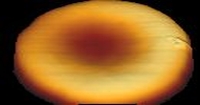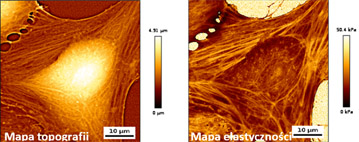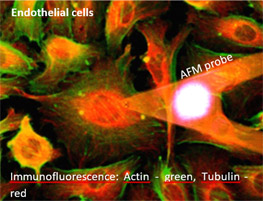Nanomechanics of Biological Systems

Cells are considered the most basic units of life. The changes that occur in them trigger cascades of events, which inevitably lead to dysfunctions propagating through the tissues and body organs. Such an outcome results in the development of severe diseases, which influence functioning of the whole organism. As such, the idea of bringing the focus to the intracellular processes, combined with the awareness about their consequences and meaning – it has appeared to be the main investigative goal pursued in our scientific group.

In detail, we focus on the examination of changes in the mechanical properties and adhesion of cells, which represent the specific kinds of responses to the internally ongoing processes, caused by the biological or chemical factors. A question arises, what can be labelled as the mechanical properties of a cell. The following answer would include a set of concepts involving elasticity (or stiffness, looking from another perspective) of the whole cell or its chosen parts (e.g. cortical cytoskeleton, cell nuclei). The cellular reactions to the influence of acting external factors often lead to the occurrence of changes in the structure of cytoskeleton. Structural changes of cytoskeleton are represented by the changes in cell elasticity. Going further, by the careful observation of the changes in the cell elasticity, we are capable of assessing the physiological condition of examined cells, while discovering their developing dysfunctions, still during the early stage. One of the particularly important issues investigated through our examinations is the assessment of the thickness and spread of the glycocalyx layer, that covers the surface of certain cells. The structure of glycocalyx, which covers the cell membrane, can be compared to a model of polysaccharide brush – one that serves as the protection and determines the cellular adhesion properties, and which constitutes a medium partaking in the signalling pathways between cells. Loss of the glycocalyx layer, or even only reduction in its thickness, carries the severe consequences to bear by the cell by the unfavourable impact on its functionality.
The research topics led by our group refer to the specific medical issues, related to the evolution of diseases such as circulatory system pathologies (e.g. hypertension), diabetes, carcinogenesis processes, anomalies of the red blood cells, or the courses of viral infections. The derived experimental models are used by us also for the purpose of testing new remedies, including the cardioprotective, antidiabetic, and anticancer drugs. Our examinations are carried out not only on the cellular models, but on the tissues as well.

The main research tool, on which we base our scientific activities, is the atomic force microscope (AFM) – the basic instrument of nanotechnologists, which has entered the canon of biomedical studies. The AFM technique provides a wide range of possibilities that can be used during our research – from the imaging of cell surface structure (in correlation with visualization of the submembrane cytoskeleton), through the examinations of adhesive interactions (by the method of force spectroscopy), to the measurements of mechanical properties by the method of nanoindentation with AFM probe. Through the development of possibilities to implement AFM examinations in the studies of biological structures, we use a variety of probe kinds, as well as a wide range of data analysis methods to present for the each tested material its unique mechanical changes – objectively and clearly. In our work, we connect the AFM methods with fluorescence microscopy and biochemical tests in order to search for the mechanisms that determine the changes in adhesion and nanomechanical properties in a richer possibility spectrum.
Group members
- Dr hab. Marta Targosz-Korecka - Head
- Mgr Agata Kubisiak - PhD Student
- Mgr Patrycja Twardawa - PhD Student
 dr hab. Marta Targosz-Korecka
dr hab. Marta Targosz-Korecka